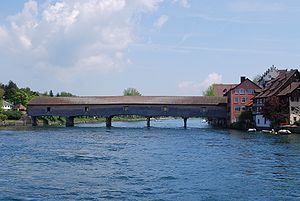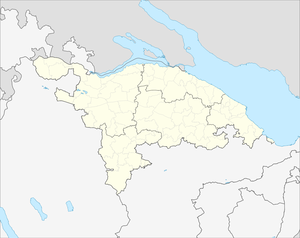Rhine bridge Diessenhofen – Gailingen
Coordinates: 47 ° 41 ′ 26 " N , 8 ° 45 ′ 2" E ; CH1903: six hundred ninety-eight thousand four hundred and eighty-nine / 283035
| Rhine bridge Diessenhofen – Gailingen | ||
|---|---|---|
| use | Road bridge | |
| Crossing of | Rhine , km 35.2 | |
| place | Diessenhofen , Gailingen on the Upper Rhine | |
| construction | Covered wooden bridge | |
| overall length | 86.7 m | |
| width | 6.1 m | |
| Longest span | 17.6 m | |
| completion | 1816 | |
| location | ||
|
|
||
The Rhine bridge Diessenhofen – Gailingen is a road bridge that spans the High Rhine between Diessenhofen and Gailingen and the border between Switzerland and Germany. The covered wooden bridge has a 2.8 meter wide lane and can be used by vehicles with a total weight of up to 10 tons. It is the only completely preserved wooden bridge on the Upper Rhine and is one of the Pfahljoch bridges that are rare today . In 1972 the building owned by the city of Diessenhofen was declared a "Protected Monument" by the Swiss Confederation and the Canton of Thurgau . It has been under federal protection since 1981.
history
Movement of goods in a north-south direction and the protection of Kyburgian property north of the Rhine probably led to the construction of a fixed Rhine crossing at Diessenhofen as early as 1180. The first wooden bridge is documented for the year 1292. The oldest illustration from 1548 shows an open wooden bridge with eight pile yokes and stone bridge gates on both sides. The bridge opening in front of the two-storey city gate was designed as a drawbridge for better defense . The bridge toll was the most important source of income for the community at that time. This also meant that the frequent repair work on the open wooden bridge structure had to be financed.
Due to increasing serious defects, the bridge was replaced from October 1667 to February 1668 by a new building by the Schaffhausen master builder Heinrich Altenburg. The wooden construction, which was again open, had six pile bays and was founded in the middle of the bridge on 14 meter long piles, some with iron spikes, 1.5 to 2.5 meters deep rammed into the river bed. A total of 52 oaks , 2 beeches and 3 pines were used. On October 8, 1799, retreating Russian troops set the bridge on fire.
After an emergency bridge from 1801, the Diessenhofen community commissioned the Schaffhausen municipal works foreman Andreas Widtmer to build a new bridge over the Rhine in 1814. The structure still standing today, a roofed wooden bridge with five openings, was erected by autumn 1816. The construction costs amounted to 25,871 guilders . In April 1865 the bridge was raised 78 centimeters to improve the passage. A bomb drop by the United States Army Air Forces on November 9, 1944 destroyed the German bridge section including the abutment . The US paid the repair costs of 70,000 francs. In 1947 the bridge was usable again. Repairs followed in 1973 and 1996. In 2003 all the yoke piles in the water were replaced.
construction
The wooden bridge has five fields with spans of 17.5 meters (according to another source 18.9 meters,) 17.6 meters, 17.2 meters, 15.2 meters and 16.2 meters. The main supporting structure in the longitudinal direction consists of a double truss . Wooden planks form the roadway. These lie on longitudinal girders that transfer the loads into the truss via cross girders and hanging columns. The load-bearing components are made of oak and the cladding is made of cheaper softwood . The clear width of the bridge between the walls is 5.05 meters.
The bridge piers each consist of a row of nine, 9.8 meter long oak piles, which are connected by wooden beams and wooden St. Andrew's crosses . Up until the repair in 2002, the piles had embedded around 2 meters into the bed of the Rhine. Since then, these have been supported by a reinforced concrete beam that is founded on bored piles .
shipping

The clearance height of the bridge is so low that ships of the Swiss shipping company Untersee and Rhein lower the bow masts, cabin and awning before passing through. In the event of flooding, the structure cannot be passed and Diessenhofen has to compensate the shipping company. Passengers then have to bypass the bridge on foot in order to board another ship on the side in the direction of travel.
See also
literature
- Jörg Schlaich, Matthias Schüller: Engineering manager Baden-Württemberg. Bauwerk Verlag, Berlin 1999, ISBN 3-934369-01-4 , p. 74.
- Hans Rudolf Stierli, Erwin Stucki, Paul Wüst: Before the construction of the N4: the Rhine crossings between Stein am Rhein and Eglisau. In: Rhine bridge N4. Edited by the National Road Office of the Canton of Schaffhausen. Meier Verlag, Schaffhausen 1995, ISBN 3-85801-112-6 .
Web links
- IVS documentation, TG 413.2.1, Diessenhofer Rheinbrücke (PDF file; 581 kB)
- R. Sehringer: Diessenhofen and the importance of the Rhine bridge ( Memento from September 21, 2013 in the Internet Archive )
Individual evidence
- ↑ Hans Rudolf Stierli, Erwin Stucki, Paul Wüst: Before the construction of the N4: The Rhine crossings between Stein am Rhein and Eglisau , p. 31.
- ↑ RailAway combined offer Rhine Falls & URh shipping
|
The next bridge upstream: the railway bridge at Hemishofen |
Bridges over the Rhine |
The next bridge down the river: Rheinbrücke Feuerthalen |


